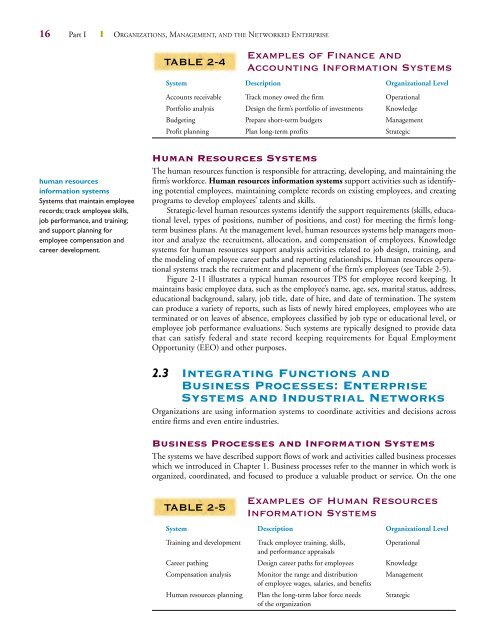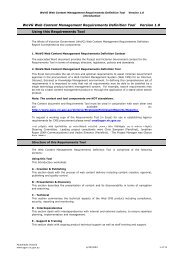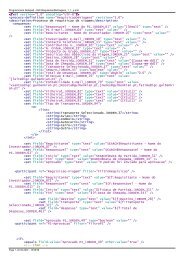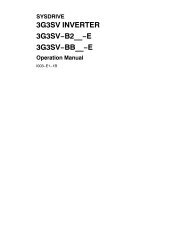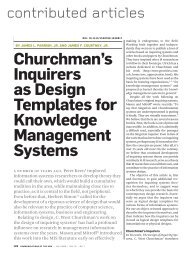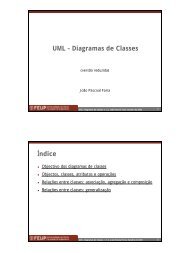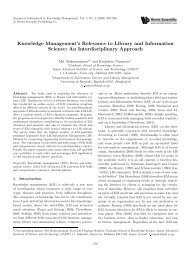2 Information Systems in the Enterprise - Main Web
2 Information Systems in the Enterprise - Main Web
2 Information Systems in the Enterprise - Main Web
Create successful ePaper yourself
Turn your PDF publications into a flip-book with our unique Google optimized e-Paper software.
16 Part I ❙ ORGANIZATIONS, MANAGEMENT, AND THE NETWORKED ENTERPRISE<br />
human resources<br />
<strong>in</strong>formation systems<br />
<strong>Systems</strong> that ma<strong>in</strong>ta<strong>in</strong> employee<br />
records; track employee skills,<br />
job performance, and tra<strong>in</strong><strong>in</strong>g;<br />
and support plann<strong>in</strong>g for<br />
employee compensation and<br />
career development.<br />
TABLE 2-4<br />
Human Resources <strong>Systems</strong><br />
The human resources function is responsible for attract<strong>in</strong>g, develop<strong>in</strong>g, and ma<strong>in</strong>ta<strong>in</strong><strong>in</strong>g <strong>the</strong><br />
firm’s workforce. Human resources <strong>in</strong>formation systems support activities such as identify<strong>in</strong>g<br />
potential employees, ma<strong>in</strong>ta<strong>in</strong><strong>in</strong>g complete records on exist<strong>in</strong>g employees, and creat<strong>in</strong>g<br />
programs to develop employees’ talents and skills.<br />
Strategic-level human resources systems identify <strong>the</strong> support requirements (skills, educational<br />
level, types of positions, number of positions, and cost) for meet<strong>in</strong>g <strong>the</strong> firm’s longterm<br />
bus<strong>in</strong>ess plans. At <strong>the</strong> management level, human resources systems help managers monitor<br />
and analyze <strong>the</strong> recruitment, allocation, and compensation of employees. Knowledge<br />
systems for human resources support analysis activities related to job design, tra<strong>in</strong><strong>in</strong>g, and<br />
<strong>the</strong> model<strong>in</strong>g of employee career paths and report<strong>in</strong>g relationships. Human resources operational<br />
systems track <strong>the</strong> recruitment and placement of <strong>the</strong> firm’s employees (see Table 2-5).<br />
Figure 2-11 illustrates a typical human resources TPS for employee record keep<strong>in</strong>g. It<br />
ma<strong>in</strong>ta<strong>in</strong>s basic employee data, such as <strong>the</strong> employee’s name, age, sex, marital status, address,<br />
educational background, salary, job title, date of hire, and date of term<strong>in</strong>ation. The system<br />
can produce a variety of reports, such as lists of newly hired employees, employees who are<br />
term<strong>in</strong>ated or on leaves of absence, employees classified by job type or educational level, or<br />
employee job performance evaluations. Such systems are typically designed to provide data<br />
that can satisfy federal and state record keep<strong>in</strong>g requirements for Equal Employment<br />
Opportunity (EEO) and o<strong>the</strong>r purposes.<br />
2.3 Integrat<strong>in</strong>g Functions and<br />
Bus<strong>in</strong>ess Processes: <strong>Enterprise</strong><br />
<strong>Systems</strong> and Industrial Networks<br />
Organizations are us<strong>in</strong>g <strong>in</strong>formation systems to coord<strong>in</strong>ate activities and decisions across<br />
entire firms and even entire <strong>in</strong>dustries.<br />
Bus<strong>in</strong>ess Processes and <strong>Information</strong> <strong>Systems</strong><br />
The systems we have described support flows of work and activities called bus<strong>in</strong>ess processes<br />
which we <strong>in</strong>troduced <strong>in</strong> Chapter 1. Bus<strong>in</strong>ess processes refer to <strong>the</strong> manner <strong>in</strong> which work is<br />
organized, coord<strong>in</strong>ated, and focused to produce a valuable product or service. On <strong>the</strong> one<br />
TABLE 2-5<br />
Examples of F<strong>in</strong>ance and<br />
Account<strong>in</strong>g <strong>Information</strong> <strong>Systems</strong><br />
System Description Organizational Level<br />
Accounts receivable Track money owed <strong>the</strong> firm Operational<br />
Portfolio analysis Design <strong>the</strong> firm’s portfolio of <strong>in</strong>vestments Knowledge<br />
Budget<strong>in</strong>g Prepare short-term budgets Management<br />
Profit plann<strong>in</strong>g Plan long-term profits Strategic<br />
Examples of Human Resources<br />
<strong>Information</strong> <strong>Systems</strong><br />
System Description Organizational Level<br />
Tra<strong>in</strong><strong>in</strong>g and development Track employee tra<strong>in</strong><strong>in</strong>g, skills,<br />
and performance appraisals<br />
Operational<br />
Career path<strong>in</strong>g Design career paths for employees Knowledge<br />
Compensation analysis Monitor <strong>the</strong> range and distribution<br />
of employee wages, salaries, and benefits<br />
Management<br />
Human resources plann<strong>in</strong>g Plan <strong>the</strong> long-term labor force needs<br />
of <strong>the</strong> organization<br />
Strategic


